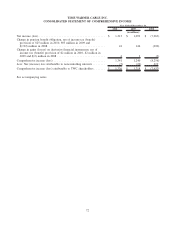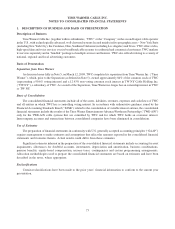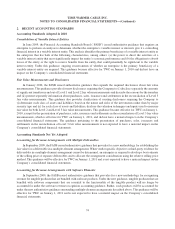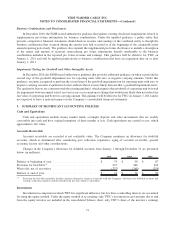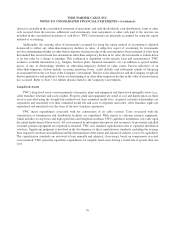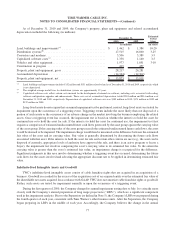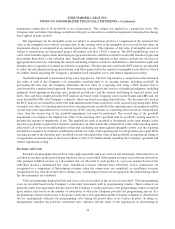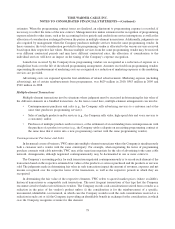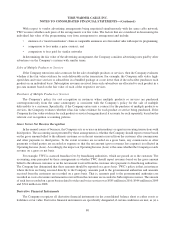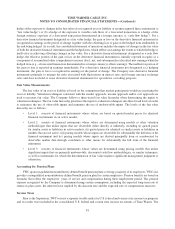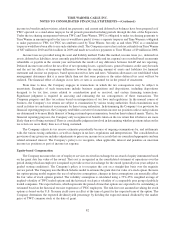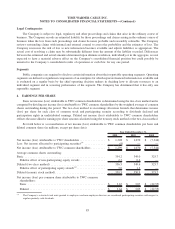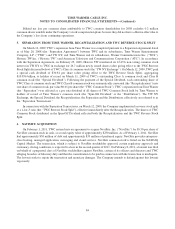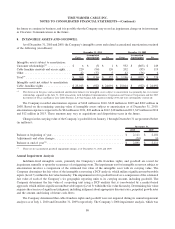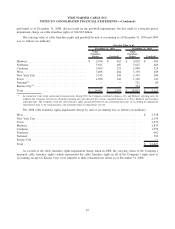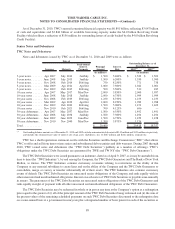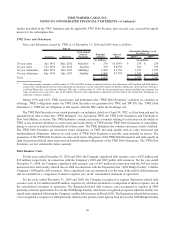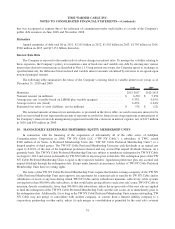Time Warner Cable 2010 Annual Report Download - page 93
Download and view the complete annual report
Please find page 93 of the 2010 Time Warner Cable annual report below. You can navigate through the pages in the report by either clicking on the pages listed below, or by using the keyword search tool below to find specific information within the annual report.hedge of the exposure to changes in the fair value of a recognized asset or liability or an unrecognized firm commitment (a
“fair value hedge”) or (b) a hedge of the exposure to variable cash flows of a forecasted transaction or a hedge of the
foreign currency exposure of a forecasted transaction denominated in a foreign currency (a “cash flow hedge”). For a
derivative financial instrument designated as a fair value hedge, the gain or loss on the derivative financial instrument is
recognized in earnings in the period of change together with the offsetting loss or gain on the hedged item attributable to
the risk being hedged. As a result, the consolidated statement of operations includes the impact of changes in the fair value
of both the derivative financial instrument and the hedged item, which reflects in earnings the extent to which the hedge is
ineffective in achieving offsetting changes in fair value. For a derivative financial instrument designated as a cash flow
hedge, the effective portion of the gain or loss on the derivative financial instrument is initially reported in equity as a
component of accumulated other comprehensive income (loss), net, and subsequently reclassified into earnings when the
hedged item (e.g., a forecasted transaction denominated in a foreign currency) affects earnings. The ineffective portion of
the gain or loss is reported in earnings immediately. For a derivative financial instrument not designated as a hedging
instrument, the gain or loss is recognized in earnings in the period of change. The Company uses derivative financial
instruments primarily to manage the risks associated with fluctuations in interest rates and foreign currency exchange
rates and does not hold or issue derivative financial instruments for speculative or trading purposes.
Fair Value Measurements
The fair value of an asset or liability is based on the assumptions that market participants would use in pricing the
asset or liability. Valuation techniques consistent with the market approach, income approach and/or cost approach are
used to measure fair value. The Company follows a three-tiered fair value hierarchy when determining the inputs to
valuation techniques. The fair value hierarchy prioritizes the inputs to valuation techniques into three broad levels in order
to maximize the use of observable inputs and minimize the use of unobservable inputs. The levels of the fair value
hierarchy are as follows:
• Level 1: consists of financial instruments whose values are based on quoted market prices for identical
financial instruments in an active market.
• Level 2: consists of financial instruments whose values are determined using models or other valuation
methodologies that utilize inputs that are observable either directly or indirectly, including (i) quoted prices
for similar assets or liabilities in active markets, (ii) quoted prices for identical or similar assets or liabilities in
markets that are not active, (iii) pricing models whose inputs are observable for substantially the full term of the
financial instrument and (iv) pricing models whose inputs are derived principally from or corroborated by
observable market data through correlation or other means for substantially the full term of the financial
instrument.
• Level 3: consists of financial instruments whose values are determined using pricing models that utilize
significant inputs that are primarily unobservable, discounted cash flow methodologies, or similar techniques,
as well as instruments for which the determination of fair value requires significant management judgment or
estimation.
Accounting for Pension Plans
TWC sponsors qualified noncontributory defined benefit pension plans covering a majority of its employees. TWC also
provides a nonqualified noncontributory defined benefit pension plan for certain employees. Pension benefits are based on
formulas that reflect the employees’ years of service and compensation during their employment period. The pension
expense recognized by the Company is determined using certain assumptions, including the expected long-term rate of
return on plan assets, the interest factor implied by the discount rate and the expected rate of compensation increases.
Income Taxes
Prior to the Separation, TWC was not a separate taxable entity for U.S. federal and various state income tax purposes
and its results were included in the consolidated U.S. federal and certain state income tax returns of Time Warner. The
81
TIME WARNER CABLE INC.
NOTES TO CONSOLIDATED FINANCIAL STATEMENTS—(Continued)



